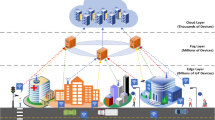Abstract
Fog computing is meant to bring the cloud resource closer to the edge of the Internet so that devices can access the back end services much faster. Additionally, the services hosted at the fogs can be customized to fit the local needs. Because fogs are dispersed throughout the network, each installation will have limited resources. This makes resource management a very critical issue. In this paper, we present a two-step resource management approach for fog computing. The first step decides the allocation of the devices to the fogs. The fogs are allocated in a two-tiered manner. That is, for each device, a home fog and a pool of backup fogs are allocated. In the second step, the requests from the devices are distributed to the allocated fogs or the cloud. Using simulation studies, we compared the performance of the proposed request distribution algorithm against existing ones. The results indicate that our request distribution algorithm outperforms existing ones.






Similar content being viewed by others
References
Aazam M, Huh E (2014) Fog computing and smart gateway based communication for cloud of things. In: 2014 International conference on future internet of things and cloud, pp 464–470. https://doi.org/10.1109/FiCloud.2014.83
Bonomi F, Milito R, Zhu J, Addepalli S (2012) Fog computing and its role in the internet of things. In: Proceedings of the first edition of the mcc workshop on mobile cloud computing, MCC ’12, ACM, New York, NY, USA, pp 13–16. https://doi.org/10.1145/2342509.2342513
Cappuccio D (2018) The data center is dead. https://blogs.gartner.com/david_cappuccio/2018/07/26/the-data-center-is-dead/
Fadahunsi O (2018) JAMCloud simulator. https://github.com/LekanF/JAMCloud
GrowthEnabler: Market Pulse Report, Internet of Things (2017). https://growthenabler.com/flipbook/pdf/IOT%20Report.pdf
Hoang D, Dang TD (2017) FBRC: optimization of task scheduling in fog-based region and cloud. In: 2017 IEEE Trustcom/BigDataSE/ICESS, pp 1109–1114. https://doi.org/10.1109/Trustcom/BigDataSE/ICESS.2017.360
Hou IH, Zhao T, Wang S, Chan K (2016) Asymptotically optimal algorithm for online reconfiguration of edge-clouds. In: Proceedings of the 17th ACM international symposium on mobile ad hoc networking and computing, MobiHoc ’16, ACM, New York, NY, USA, pp 291–300. https://doi.org/10.1145/2942358.2942363
Karatas M, Razi N, Tozan H (2016) A comparison of p-median and maximal coverage location models with q-coverage requirement. Procedia Eng 149:169–176
Lebre A, Pastor J, Simonet A, Desprez F (2017) Revising openstack to operate fog/edge computing infrastructures. In: 2017 IEEE international conference on cloud engineering (IC2E), pp 138–148. https://doi.org/10.1109/IC2E.2017.35
L’Ecuyer P, Meliani L, Vaucher J (2002) SSJ: a framework for stochastic simulation in Java. In: Yücesan E, Chen CH, Snowdon JL, Charnes JM (eds) Proceedings of the 2002 winter simulation conference, IEEE Press, pp 234–242. http://simul.iro.umontreal.ca/ssj/indexe.html
Mitzenmacher M (2001) The power of two choices in randomized load balancing. IEEE Trans Parallel Distrib Syst 12(10):1094–1104. https://doi.org/10.1109/71.963420
Moradi E, Bidkhori M (2009) Single facility location problem. In: Facility location, Springer, pp 37–68
Oueis J, Strinati EC, Barbarossa S (2015) The fog balancing: load distribution for small cell cloud computing. In: 2015 IEEE 81st vehicular technology conference (VTC spring), pp 1–6. https://doi.org/10.1109/VTCSpring.2015.7146129
Postel J (1981) Transmission control protocol. https://tools.ietf.org/html/rfc793
Reiss C, Wilkes J, Hellerstein JL (2011) Google cluster-usage traces: format \(+\) schema. Google Inc., White Paper, pp 1–14
Skarlat O, Nardelli M, Schulte S, Borkowski M, Leitner P (2017) Optimized IoT service placement in the fog. Serv Oriented Comput Appl 11(4):427–443
Skarlat O, Schulte S, Borkowski M, Leitner P (2016) Resource provisioning for IOT services in the fog. In: 2016 IEEE 9th international conference on service-oriented computing and applications (SOCA), pp 32–39. https://doi.org/10.1109/SOCA.2016.10
Song Y, Yau SS, Yu R, Zhang X, Xue G (2017) An Approach to QoS-based task distribution in edge computing networks for IoT applications. In: 2017 IEEE international conference on edge computing (EDGE), pp 32–39. https://doi.org/10.1109/IEEE.EDGE.2017.50
Stojmenovic I (2014) Fog computing: a cloud to the ground support for smart things and machine-to-machine networks. In: 2014 Australasian telecommunication networks and applications conference (ATNAC), pp 117–122. https://doi.org/10.1109/ATNAC.2014.7020884
Taleb T, Samdanis K, Mada B, Flinck H, Dutta S, Sabella D (2017) On multi-access edge computing: a survey of the emerging 5G network edge cloud architecture and orchestration. IEEE Commun Surv Tutor 19(3):1657–1681. https://doi.org/10.1109/COMST.2017.2705720
The University of Adelaide: The Internet Topology Zoo. http://www.topology-zoo.org/files/Cogentco.gml
Vaquero LM, Rodero-Merino L (2014) Finding your way in the fog: towards a comprehensive definition of fog computing. SIGCOMM Comput Commun Rev 44(5):27–32. https://doi.org/10.1145/2677046.2677052
Yi S, Hao Z, Qin Z, Li Q (2015) Fog computing: platform and applications. In: 2015 Third IEEE workshop on hot topics in web systems and technologies (HotWeb), pp 73–78. https://doi.org/10.1109/HotWeb.2015.22
Yousefpour A, Ishigaki G, Jue JP (2017) Fog computing: towards minimizing delay in the internet of things. In: 2017 IEEE international conference on edge computing (EDGE), pp 17–24. https://doi.org/10.1109/IEEE.EDGE.2017.12
Zhang B, Mor N, Kolb J, Chan DS, Lutz K, Allman E, Wawrzynek J, Lee EA, Kubiatowicz J (2015) The Cloud is not enough: saving IoT from the cloud. In: HotStorage
Funding
Partially supported by a Discovery Research Grant from Natural Sciences and Engineering Research Council of Canada.
Author information
Authors and Affiliations
Corresponding author
Additional information
Publisher's Note
Springer Nature remains neutral with regard to jurisdictional claims in published maps and institutional affiliations.
Olamilekan Fadahunsi was supported by a Scholarship from the Nigerian Government through the Federal Scholarship Board PRESSID Program.
Rights and permissions
About this article
Cite this article
Fadahunsi, O., Maheswaran, M. Locality sensitive request distribution for fog and cloud servers. SOCA 13, 127–140 (2019). https://doi.org/10.1007/s11761-019-00260-2
Received:
Revised:
Accepted:
Published:
Issue Date:
DOI: https://doi.org/10.1007/s11761-019-00260-2




